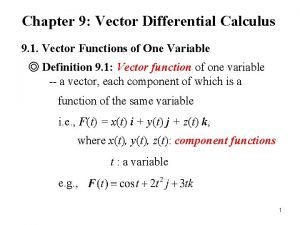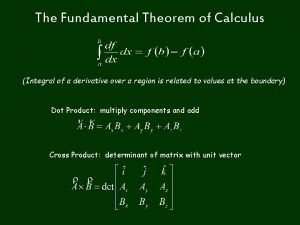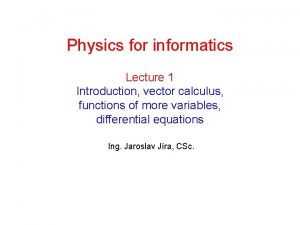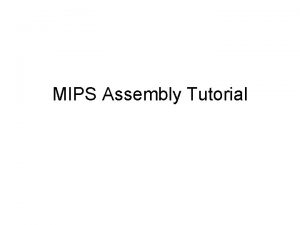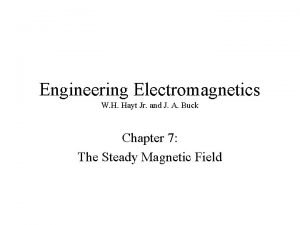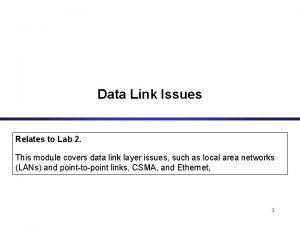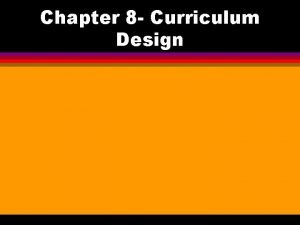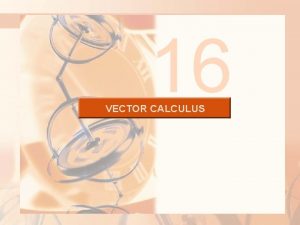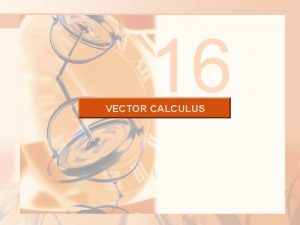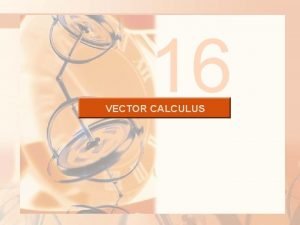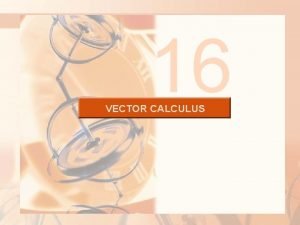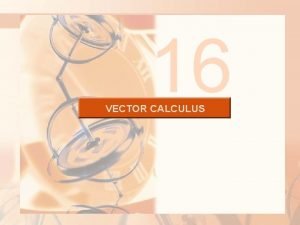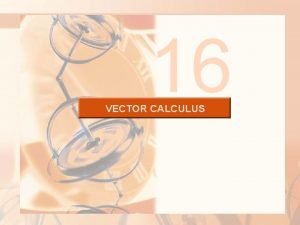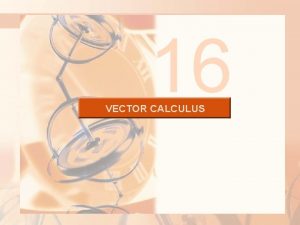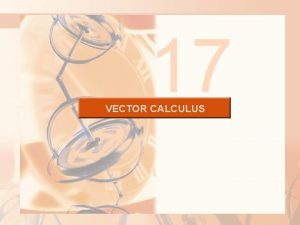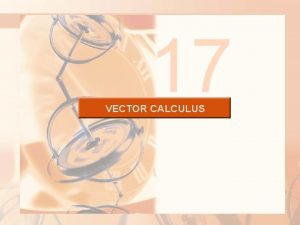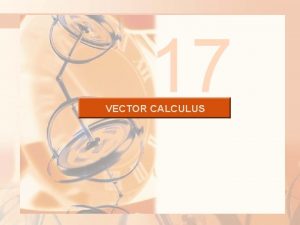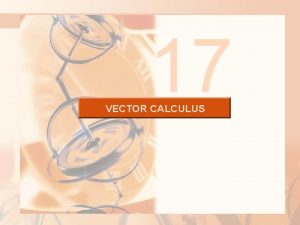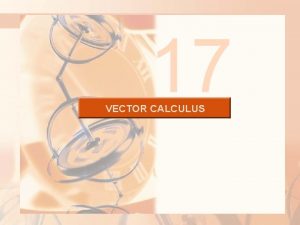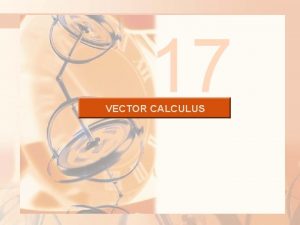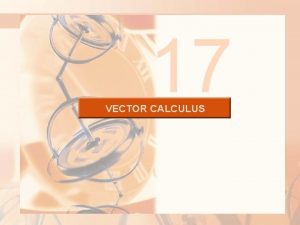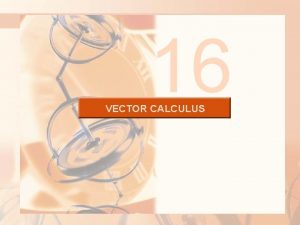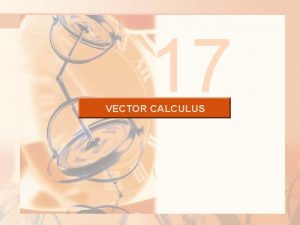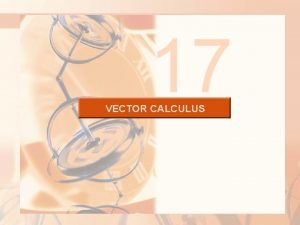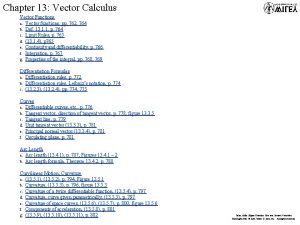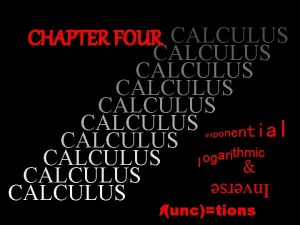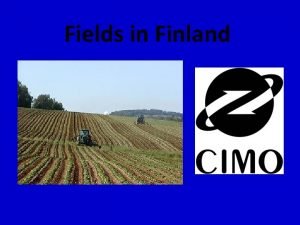16 Vector Calculus 16 1 Vector Fields Vector























- Slides: 23

16 Vector Calculus

16. 1 Vector Fields

Vector Fields This shows air velocity vectors that indicate the wind speed and direction at points 10 m above the surface elevation in the San Francisco Bay area. Associated with every point in the air we can imagine a wind velocity vector. This is an example of a velocity vector field. 3

Vector Fields Other examples of velocity vector fields: ocean currents and flow past an airfoil. Velocity vector fields 4

Vector Fields on R 2 Another type of vector field, called a force field, associates a force vector with each point in a region. An example of this is the gravitational force field. 5

Vector Fields on R 2 The best way to picture a vector field is to draw the arrow representing the vector F(x, y) starting at the point (x, y). Of course, it’s impossible to do this for all points (x, y), but we can gain a reasonable impression of F by doing it for a few representative points in D: Vector field on 6

Vector Fields on R 2 Since F(x, y) is a two-dimensional vector, we can write it in terms of its component functions P and Q as follows: F(x, y) = P(x, y) i + Q(x, y) j = P(x, y), Q(x, y) or, for short: F=Pi+Qj Notice that P and Q are scalar functions of two variables and are sometimes called scalar fields to distinguish them from vector fields. 7

Vector Fields on R 3 A vector field F on is pictured here: Vector field on We can express it in terms of its component functions P, Q, and R as: F(x, y, z) = P(x, y, z) i + Q(x, y, z) j + R(x, y, z) k 8

Vector Fields on R 3 As with the vector functions, we can define continuity of vector fields and we say that F is a continuous vector field iff its component functions P, Q, and R are continuous. We sometimes identify a point (x, y, z) with its position vector: x = x, y, z and write: F(x) instead of F(x, y, z). Then F becomes a function that assigns a vector F(x) to a vector x. 9

Example 1 A vector field on is defined by F(x, y) = –y i + x j. Describe F by sketching some of the vectors F(x, y) similar to the figure here: Vector field on Here is the command to view this in Wolfram Alpha 10

Example 1 – Solution F(x, y) = –y i + x j • Since F(1, 0) = j, we draw the vector j = 0, 1 starting at the point (1, 0) • Since F(0, 1) = –i, we draw the vector – 1, 0 with starting point (0, 1). • Continuing in this way, we calculate several other representative values of F(x, y) in the table and draw the corresponding vectors to represent the vector field in the figure: It appears that each arrow is tangent to a circle with center the origin. 11

Example 1 – Solution cont’d To confirm this, we take the dot product of the position vector x = x i + y j with the vector F(x) = F(x, y): x F(x) = (x i + y j) (–y i + x j) = –xy + yx = 0 This shows that F(x, y) is perpendicular to the position vector x, y and is therefore tangent to a circle with center the origin and radius Notice also that so the magnitude of the vector F(x, y) is equal to the radius of the circle. 12

Example 2 Imagine a fluid flowing steadily along a pipe and let V(x, y, z) be the velocity vector at a point (x, y, z). Then V assigns a vector to each point (x, y, z) in a certain domain E (the interior of the pipe) and so V is a vector field on called a velocity field. A possible velocity field is illustrated here: Velocity field in fluid flow The speed at any given point is indicated by the length of the arrow. Velocity fields also occur in other areas of physics. For instance, the vector field in Example 1 could be used as the velocity field describing the counterclockwise rotation of a wheel. 13

Example 3 Newton’s Law of Gravitation states that the magnitude of the gravitational force between two objects with masses m and M is: where r is the distance between the objects and G is the gravitational constant. (This is an example of an inverse square law. ) Let’s assume that the object with mass M is located at the origin in. (For example, M could be the mass of the earth and the origin would be at its center. ) 14

Example 3 cont’d Let the position vector of the second object with mass m be x = x, y, z. Then r = | x |, so r 2 = | x |2. The gravitational force exerted on this second object acts toward the origin, and the unit vector in this direction is: Therefore the gravitational force acting on the object at x = x, y, z is: [In Physics we use the notation r instead of x for the position vector so F = –(m. MG/r 3)r. ] The function given by Equation 3 is an example of a vector field, called the gravitational field, because it associates a vector [the force F(x)] with every point x in space. 15

Example 3 cont’d Formula 3 is a compact way of writing the gravitational field, but we can also write it in terms of its component functions by using the facts that x=xi+yj+zk and therefore: Gravitational force field 16

Example 4 Suppose an electric charge Q is located at the origin. According to Coulomb’s Law, the electric force F(x) exerted by this charge on a charge q located at a point (x, y, z) with position vector x = x, y, z is: where ε is a constant (that will depend on the units used). For like charges, we have q. Q > 0 and the force is repulsive; for unlike charges, we have q. Q < 0 and the force is attractive. 17

Example 4 cont’d Notice the similarity between the formulas for Gravitational field and the formula for Electrical field. Both vector fields are examples of force fields. Instead of considering the electric force F, physicists often consider the force per unit charge: Then E is a vector field on called the electric field of Q: 18

Gradient Fields 19

Gradient Fields In R 2, if f is a scalar function of two variables, its gradient f is defined by: f (x, y) = fx(x, y) i + fy(x, y) j Likewise in R 3, if f is a scalar function of three variables, its gradient is a vector field given by: f (x, y, z) = fx(x, y, z) i + fy(x, y, z) j + fz(x, y, z) k f is really a vector field and is called a gradient vector field. 20

Example 5 Find the gradient vector field of f (x, y) = x 2 y – y 3. Plot the gradient vector field together with a contour map of f. How are they related? Solution: The gradient vector field is given by: This graph shows a contour map of f with the gradient vector field. Notice that the gradient vectors are perpendicular to the level curves. Closely spaced level curves indicate a steep graph so with larger gradient vector. On Wolfram Alpha: Find the gradient vector: grad (x^2 y-y^3) Plot the vector field: Plot Vector Field 21

Gradient Fields A vector field F is called a conservative vector field if there is a function f such that F is its gradient: F = f. f is then called the potential function for F. Not all vector fields are conservative, but such fields do arise frequently in physics. 22

Gradient Fields The gravitational field F in Example 3 is conservative because if we write: Then F is the gradient of f. (A vector field F is called a conservative vector field if there is a function f such that F is its gradient: F = f. ) 23
 Red fields to green fields
Red fields to green fields Slope fields ap calculus
Slope fields ap calculus Directional derivative in vector calculus
Directional derivative in vector calculus Fundamental theorem of vector calculus
Fundamental theorem of vector calculus Vector differentiation
Vector differentiation Vector product mathematica
Vector product mathematica Ao fields
Ao fields Mips example code
Mips example code Empower custom fields validation
Empower custom fields validation Equation of continuity for time varying fields
Equation of continuity for time varying fields 2829 elysian fields avenue
2829 elysian fields avenue Maxwell
Maxwell Electric currents and magnetic fields
Electric currents and magnetic fields New consultant training
New consultant training Virtual fields method
Virtual fields method Cambodia map
Cambodia map How many fields in computer science
How many fields in computer science Potential fields
Potential fields Ethernet ii frame fields
Ethernet ii frame fields Subject centered design curricular emphasis
Subject centered design curricular emphasis Vimy ridge memorial
Vimy ridge memorial Kotebe metropolitan university departments list
Kotebe metropolitan university departments list Wanton fields
Wanton fields Into the fields internship
Into the fields internship


